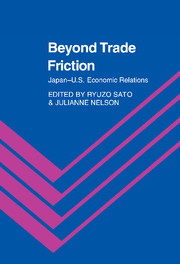Book contents
- Frontmatter
- Contents
- Foreword by Richard R. West
- Preface
- List of contributors
- 1 Beyond trade friction: an overview
- Part I Macroeconomic policy issues
- Part II Commercial policy issues
- Part III Financial integration issues
- 8 Competitive performance and strategic positioning in international financial services
- 9 Capital transfers from Japan to the United States: a means of avoiding trade friction
- 10 The efficiency of U.S. and Japanese stock markets
- Index
9 - Capital transfers from Japan to the United States: a means of avoiding trade friction
Published online by Cambridge University Press: 22 March 2010
- Frontmatter
- Contents
- Foreword by Richard R. West
- Preface
- List of contributors
- 1 Beyond trade friction: an overview
- Part I Macroeconomic policy issues
- Part II Commercial policy issues
- Part III Financial integration issues
- 8 Competitive performance and strategic positioning in international financial services
- 9 Capital transfers from Japan to the United States: a means of avoiding trade friction
- 10 The efficiency of U.S. and Japanese stock markets
- Index
Summary
Introduction
This chapter examines rationales for capital transfer abroad by Japanese institutional investors and multinational enterprises. Both groups have invested heavily in the United States, running the risk of losses caused by the appreciation of the yen. In many instances, this money has been invested in the United States with little concern for the profitability of local production. Instead, the investments represent an effort to avoid trade friction.
The true meaning of Japanese corporate behavior, which is considerably different from that observed in other industrial nations, stems primarily from political and institutional factors rather than economic ones. In recent years, economic issues involving the United States and Japan have been much politicized. Japan has also had to confront many obstacles at home, such as business regulations and traditions, which have hindered its efforts to become a dominant capital exporting country.
In the future, Japan needs to promote direct investment in the United States through Japanese multinational enterprises, rather than portfolio investment channeled through Japanese financial institutions. This will serve not only to reduce trade friction, but also to revitalize the American manufacturing sector and to restructure the Japanese economy.
Japan's role as a major capital exporting country
In its 1984 economic white paper, the Japanese government announced that the structure of the Japanese economy had led Japan to become a net capital exporter. In particular, the government predicted that Japan was likely to generate a current account surplus of more than 1 percent of GNP for the foreseeable future.
- Type
- Chapter
- Information
- Beyond Trade FrictionJapan-US Economic Relations, pp. 157 - 176Publisher: Cambridge University PressPrint publication year: 1989



